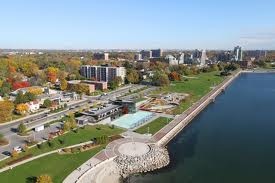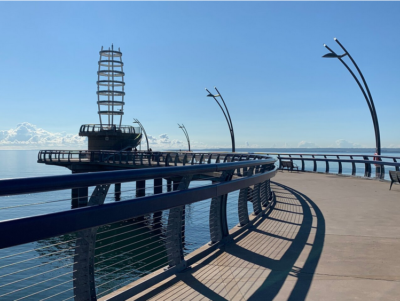June 3rd, 2025
BURLINGTON, ON
Along Lakeshore Road on a sunny morning, families stroll past cyclists, cafés are packed with remote workers, and the distant hum of weekend GO trains serves as a backdrop to how quickly Burlington has become the GTHA’s sweet spot.
Online conveniences, from buying vintage teak on Facebook Marketplace to checking for the best casino sites in Canada on sites like online-casinos.com for Friday evening entertainment, now rank alongside the city’s famous benchmarks: lake vistas, safe streets, and neighbourly charm. That blend of old-style and tech-savviness is driving record interest from first-time buyers, downsizing Torontonians, and newcomers alike.
Consistently Ranked Among Canada’s Best
Independent studies continue to place Burlington at or close to the top of national livability rankings. MovingWaldo’s 2024 report card graded the city fifth in the country, based on its low Crime Severity Index (31.04), great employment prospects, and access to health care.
 The accolades are anything but a one-time event; MoneySense, Maclean’s, and The Globe and Mail have all highlighted Burlington’s stability and livability in recent years. For prospective residents who want peace of mind without sacrificing urban amenities, those rankings are meaningful.
The accolades are anything but a one-time event; MoneySense, Maclean’s, and The Globe and Mail have all highlighted Burlington’s stability and livability in recent years. For prospective residents who want peace of mind without sacrificing urban amenities, those rankings are meaningful.
Housing: A Balanced Market in a Volatile Region
Greater Toronto’s housing story is often one of sticker shock, but Burlington has been able to sustain a relative affordability edge. The average resale price was $1.12 million in May 2025, still steep, but competitive with Toronto’s $1.29 million average and Oakville’s $1.48 million. Interest rate stability and a projected 4.5 per cent price gain for 2025 are indicative of a balanced market, not a speculative boom.
Single-detached product remains the most sought-after segment, reports RE/MAX, while a steady supply of mid-rise condos near GO stations offers entry points for young professionals and downsizers.
Impeccable Connectivity Fuels Commuter Confidence
Location is destiny, and Burlington’s is at the intersection of two economic powerhouses. Drivers have simple access to the QEW, Highway 403, and the 407 ETR, but the larger news is transit: Metrolinx’s GO Expansion program promises 15-minute, two-way, all-day service on the Lakeshore West line, sewing Burlington, Hamilton, and downtown Toronto into a reliable, electrified corridor.
New pedestrian overpasses, schedule enhancements, and integrated Burlington Transit bus routes are already being rolled out, reflecting long-term confidence in car-optional living. For companies that promote hybrid work, that reliability opens the talent pool in both directions.
Nature at the Doorstep, Lake at the Front Porch
From the 900-metre pier next to Spencer Smith Park to the Bruce Trail limestone cliffs, a 10-minute drive north, Burlington offers a return-to-nature experience without ever having to leave the city.
More than 1,400 hectares of legally protected green space thread through the neighbourhoods, including the Royal Botanical Gardens and Hidden Valley Park, which ideally cater to a post-pandemic hunger for outdoor recreation and mental-health refuge. Waterfront access also fuels a paddle-sport culture in boom, while frequent “park-and-bike” trailheads put the Escarpment within reach of every skill level.
A Cultural Calendar That Punches Above Its Weight
Quality of life isn’t necessarily measured in square footage. Burlington’s seasonal festivals and events keep residents busy all year round, none bigger than June’s Sound of Music Festival – Canada’s largest free outdoor music festival, now drawing 200,000-plus people over four days.
The Burlington Performing Arts Centre, monthly Art Gallery openings, and a craft-brewery circuit from Plains Road to Aldershot have added new dimensions to the city’s personality. Not only do these sites entertain citizens, but they also support a hospitality sector that employs thousands.
Smart Growth and Sustainable Planning
City Hall’s “Grow Bold” vision funnels density into the three GO station precincts, preserving stable family neighbourhoods while realizing provincial intensification targets. Burlington, Aldershot, and Appleby station-area mixed-use developments incorporate green roofs, EV-ready parking, and pedestrian-priority design, fulfilling buyer demand for sustainable living.
Progressive infrastructure(from the new Joseph Brant Hospital wing to district-energy pilots in Aldershot) illustrates public and private investment in climate-change resilience.
Demographics Behind the Momentum
Population forecasts released this spring have Burlington surpassing large cities along the Halton-Hamilton corridor in percentage growth, driven by interprovincial migration and a 12 per cent spike in international arrivals since 2021.
Retirees still love the city’s walkability and healthcare system, but the fastest-growing cohort is tech and business-services professionals aged 28-44 years, an age range that demands reliable broadband, vibrant public spaces, and convenient airport access. Burlington’s ability to satisfy both highly skilled singles and families is expanding its popularity and solidifying its tax base.
The Bottom Line

The northern part of the city is closed to development, leaving hundreds of acres that can be seen from Mt. Nemo.
Where livability rankings, transit investment, smart housing policy, and a multicultural range of cultural amenities converge, momentum isn’t just a marketing slogan: it’s a way of life.
Burlington’s draw is its “Goldilocks” mix of being large enough to support top-notch amenities, yet small enough that neighbours can greet each other by name; close enough to Toronto’s skyscrapers, but rimmed by treed escarpment; connected, but also firmly rooted in neighbourly feeling.
For Canadians looking for their next address, that balance is proving irresistible, and Burlington’s newest welcome mat has never looked more inviting.




















This cream puff piece has less credibility than a poorly worded real estate ad. Burlington USED TO BE a great place to live–30 years ago. But I, and all of my friends who have lived in this community for forty or more years, have noticed a marked deterioration in the quality of life. Overcrowded and congested, over-regulated and over-taxed—-Burlington is the victim of weak politicians at all levels of government who refused to represent their constituents while chasing ideological pipe-dreams.